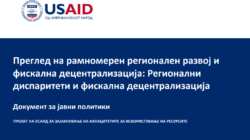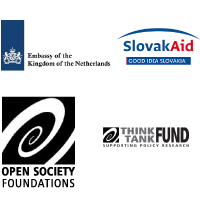The institutional positioning for coordination, implementation and monitoring of the Roma Strategy along with the National Action Plans has not been an efficient mechanism for monitoring the progress of the priorities for a long period due to a number of reasons, such as the lack of an internal monitoring system, a vague system of responsibility and accountability, powerless coordination among the ministries in the process of implementation and political support.
The National Coordinative Body with an expired mandate does not function operatively, and does not have clear guidelines and power to make changes, thus its role of monitoring and providing guidance for improvement is not fulfilled.
The budget implications related to the implementation of the subprograms seldom reflect the needs. Rather than this, they represent a reflection of political bargaining power, and in conditions of a systemic lack of adequate systems for performance monitoring (both in terms of budgeting – performance budgeting and in terms of implementation – performance measurement), it is essential to establish a system for monitoring the level of implementation of the Strategy, that is, the achievements and outcomes.
The civil sector is not familiar with the possibility of participating in the NCB nor with the manner of nomination and selection of its members. The members of the institutions are usually long-term members who are also not familiar with the duration of their mandate and state that the meetings of this coordinative body basically indicate and describe situations without a possibility to overcome the obstacles and the challenges (inter alia the necessity of increased funding as well).
The Strategy and the national action plans are to be revised, both with regard to their essence and their technique.
A segment of the measures in the national action plans in all priority areas depends on the opportunities of the civil sector, but also on donor funds, which makes the process disorganized, difficult to monitor and creates an environment with a lack of responsibility.
Employment:
o A relatively low number of Roma who use the services of the EARM and the employment measures in relation to the total number of users at a national level;
o The absolute number of Roma registered in the last three years who have been unemployed for a long period of time (waiting for employment for one or several years) has been increasing, same as their share in the total number of long-term unemployed persons in the Republic of Macedonia (from 5.3% in 2015 to 6.5% in 2017);
o The target for the percentage of unemployed Roma for 2016, which was 4.7% of the total number of unemployed persons, according to the EARM was 5.1% at the end of the year, and it has been increasing rather than decreasing, and for 2017 it is 5.2%, although the absolute number of unemployed Roma people decreased in the period from 2016 to 2017;
o The target for an improved access to employment programs for 2016 for the Roma population was overcome and it is likely that if the trend continues, the target will be reached by 2020. Housing:
o A significant segment of the measures depends on the possibilities of the civil sector, but also on donor funds, especially when it comes to legalization of homes, which makes the process disorganized, difficult to monitor, and creates an environment with a lack of responsibility for the (non)implementation;
o There are no clearly defined rules and criteria for allocation of earmarked capital grants to the LSGUs according to the subprogram for implementation of the Roma Strategy under the competence of the Ministry of Transport and Communications;
o Lack of proactive and prior identification of priority infrastructural/communal priorities of the LSGU;
o Inefficient use of public resources from loans that generate costs in the budget through interest rates in the long run;
o Lack of a database for social inclusion according to the Strategy and regular updating of the database that refers to the integration of Roma in the Republic of Macedonia, which would be an obligation of the NCB, and where information will be collected at both national and local level.
Education
o The number of scholarship holders for secondary and higher education has been increasing;
o Lack of data on primary and secondary education on a national basis, the data available to the Ministry of Education and Science (MES) and the Directorate for Development and Promotion of Education in the Languages of the Communities correspond to the language of instruction. Hence, it is difficult to measure the number of Roma students who complete secondary education;
o Some of the targets stipulated for 2020 have already been reached in 2017, the remaining activities have a trend to reach the target by 2020;
o The Directorate for Development and Promotion of Education in the Languages of the Communities does not prepare an annual operational plan that refers to the implementation of the Roma Strategy. The Directorate participates in the drafting of strategic points of the Education Strategy directly through the MES with its proposals.
Health
o The monitoring of the measures in the field of health is difficult because they are almost immeasurable and there are no data and information on the level of implementation of the NAP;
o Lack of data and information on the achievements in the field of health;
o The clearest goal in the implementation of health measures are the Roma Health Mediators;
o The need of health mediators is indispensable in municipalities where a significant number of Roma reside;
o A greater commitment on the part of the NCB to revise and monitor the NAP is required;
o People without documents, being one of the vulnerable groups, have the greatest need of healthcare services because they are socially disadvantaged and therefore these people should be in the focus.
Check out the full report for 2016 on this link: Shadow Report – Implementation of the Roma Strategy
Check out the full report for 2017 on this link: Shadow Report – Implementation of the Roma Strategy















